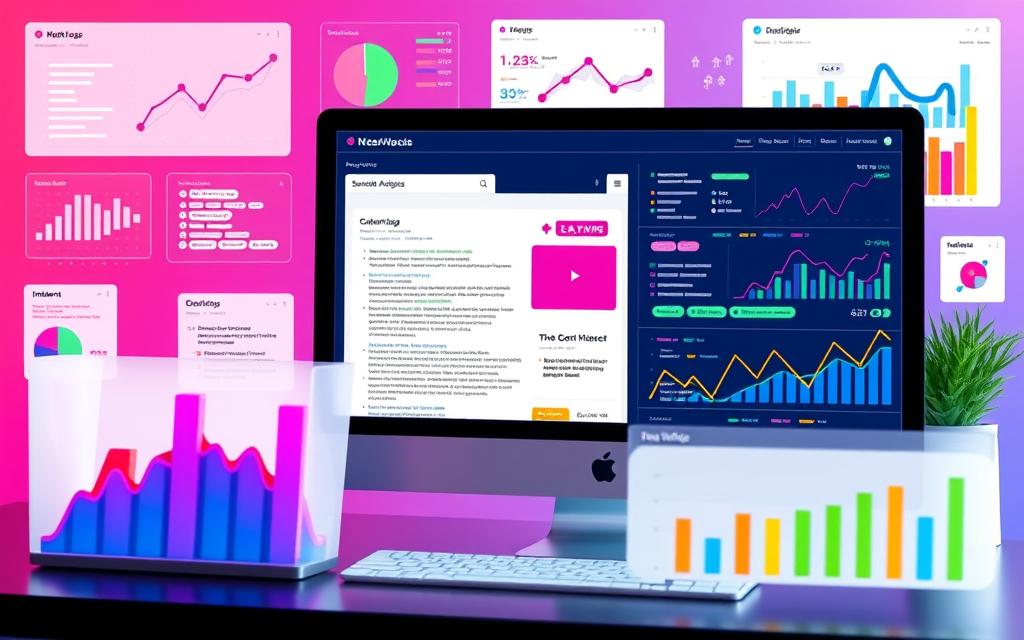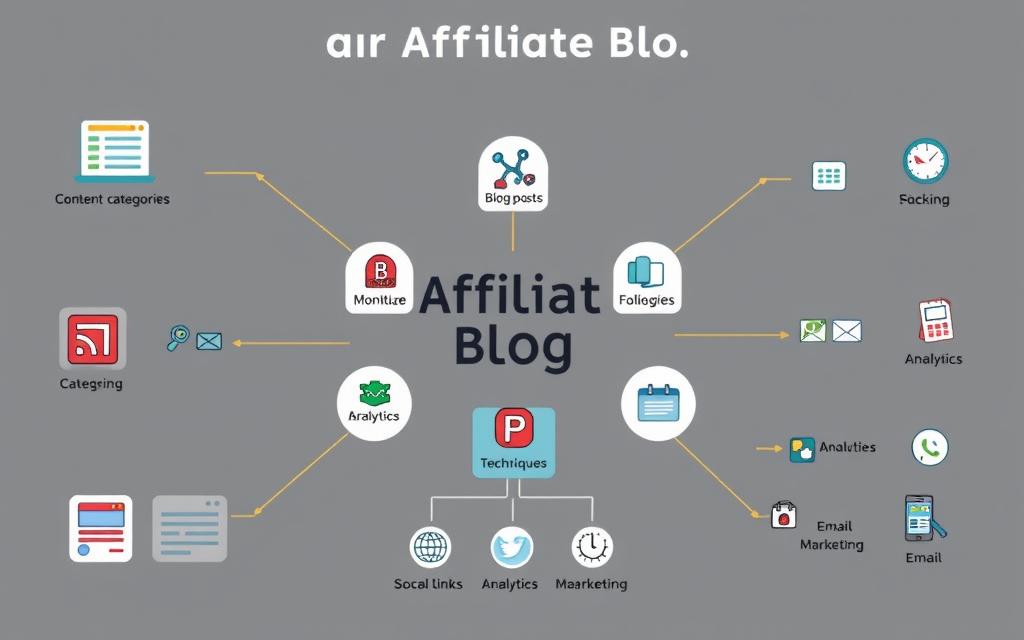In today’s digital world, making your affiliate blog content SEO-friendly is key. It helps bring in more organic traffic and boosts your affiliate marketing success. But how do you make your content shine among all the online info? The secret is in mastering SEO-driven affiliate blogging.
Want to know how to create affiliate blog content that grabs your audience’s attention and tops search engine rankings? This detailed guide will give you the top strategies and best practices. You’ll learn how to make your affiliate blog content more visible and engaging.
Key Takeaways
- Understand the fundamentals of SEO and its importance in affiliate marketing
- Leverage keyword research to identify the right topics and phrases to target
- Craft attention-grabbing blog titles that incorporate SEO-friendly elements
- Produce high-quality, engaging content that provides value to your audience
- Optimize your blog’s structure, metadata, and visuals for enhanced search engine visibility
Understanding SEO Basics for Affiliate Marketing
As an affiliate marketer, knowing the basics of search engine optimization (SEO) is key to your blog’s success. SEO helps your website show up higher in search results, making it easier for people to find. Learning SEO basics can boost your affiliate marketing efforts and help you make more sales.
What is SEO?
SEO is about making your website more visible in search engine results. It involves using keywords, creating good content, optimizing your site, and building links. These steps help search engines like Google see your site as valuable.
Importance of SEO in Affiliate Marketing
SEO is vital for affiliate marketers to bring in the right visitors to their blogs. By using the right keywords, you can draw in people looking for what you offer. This can lead to more sales and commissions, making SEO a key part of your strategy.
Key SEO Terms to Know
- Keyword: A word or phrase that people use to search for information online.
- On-page optimization: The process of optimizing individual web pages to rank higher and earn more relevant traffic in search engines.
- Off-page optimization: The process of building backlinks and other external signals to improve a website’s authority and ranking.
- Meta tags: HTML elements that provide information about a web page, such as the title, description, and keywords.
- Ranking: The position of a website or web page in the search engine results pages (SERPs).
Knowing these SEO terms will help you create a strong affiliate SEO strategy. This can drive more traffic, leads, and sales to your blog.
Researching Keywords to Target
Effective keyword research is key for a successful affiliate blog. It helps you understand what your audience is looking for. This way, you can create content that interests them and boosts your search engine ranking. We’ll look at tools and strategies for finding the right keywords, including long-tail and short-tail options.
Tools for Keyword Research
Many tools can help you find the best keywords for your blog. Some top choices include:
- Google Keyword Planner – This free tool gives insights into search volume and suggested keywords.
- Ahrefs – A detailed SEO tool that analyzes keyword difficulty and suggests related keywords.
- SEMrush – A powerful SEO suite for keyword research, competitor analysis, and traffic insights.
Long-tail vs. Short-tail Keywords
It’s crucial to know the difference between long-tail and short-tail keywords. Short-tail keywords are broad and have more competition. Long-tail keywords are specific and have less competition. Using both types can help you optimize your affiliate sites and reach your audience better.
Analyzing Competitor Keywords
Looking at your competitors’ keywords can be very helpful. Use tools like those mentioned to see their strategies and rankings. This can show you new opportunities and help you choose better keywords.
Remember, keyword research is a continuous process. Keep an eye on your performance and adjust your strategies. Stay updated with SEO trends to keep your blog visible and interesting to your audience.
Creating SEO-friendly Blog Titles
Making catchy blog titles is key for SEO and keeping readers interested. In affiliate marketing, your titles are crucial for drawing the right audience. They help drive traffic to your site. Let’s look at some ways to make SEO-friendly titles that catch the eye and boost your content.
Crafting Attention-Grabbing Titles
The title is what readers first see. It can decide if they click and read more. Use words like “proven,” “secrets,” or “new” to spark curiosity. Also, numbers or lists in titles can make your content easy to scan.
Incorporating Keywords Naturally
When making catchy titles, it’s important to include your keywords smoothly. Content optimization for affiliates and on-page SEO for affiliates should blend into your titles. Try different places for your keywords to find the best fit.
Learning to create SEO-friendly titles can boost your content optimization for affiliates. This can help you rank higher in search results. More targeted traffic to your blog means more chances for conversions.
“The difference between the almost right word and the right word is really a large matter – it’s the difference between the lightning bug and the lightning.”
– Mark Twain
Writing Quality Content that Engages
In the world of affiliate marketing, your blog’s success depends on its content quality and engagement. It’s not just about keywords. You need to create compelling, original stories that grab your readers’ attention.
Importance of Original Content
Search engines like Google value unique, high-quality content that adds real value. Don’t just copy and paste from other websites. Offer fresh views, deep analysis, and personal insights to stand out from others.
Using Clear and Concise Language
Your content should be easy to read and understand. Use simple, clear language to get your point across. Aim for an 8th-9th grade reading level to reach more readers.
The Role of Storytelling in Blogging
Storytelling makes your content more engaging and memorable. Share personal stories, case studies, or narratives that show the value of your products or services. This way, you build a strong emotional connection with your audience and boost conversion rates.
“Content is king, but context is god.” – Gary Vaynerchuk

To write engaging content, balance SEO optimization with creating valuable, relatable content. Focus on originality, clarity, and storytelling. This approach will improve your blog’s SEO and attract a loyal audience.
Optimizing Meta Descriptions
In the world of blog SEO, making your meta descriptions catchy is key. Meta descriptions are short texts under your page titles in search results. They’re crucial for getting people to click on your site.
What Makes a Catchy Meta Description?
A good meta description is short, interesting, and shows what your blog post is about. It should grab the reader’s attention and tell them to learn more. Also, using blog SEO optimization and on-page SEO for affiliates keywords can help your content show up more in search results.
Including Keywords in Meta Descriptions
When optimizing your meta descriptions, it’s important to use the right keywords. But don’t overdo it. Keyword stuffing can scare off readers. Instead, aim for descriptions that are both informative and engaging, with keywords blended in naturally.
By getting better at writing meta descriptions, you can improve your blog SEO optimization and on-page SEO for affiliates. This means more people will visit your site, leading to more clicks and sales.
Structuring Your Affiliate Blog Posts
When you write your affiliate blog posts, how you organize your content is key. Using headings, subheadings, bullet points, and links makes your site easier to read and understand. This also helps your site rank better in search engines.
Utilizing Headings and Subheadings
Use clear headings and subheadings to make your blog posts easy to scan. Mark your subheadings with
tags. This makes your content look good and helps search engines understand your content optimization for affiliates.
The Importance of Bullet Points
- Bullet points make information easy to read and understand.
- They break up long paragraphs, making your optimizing affiliate sites more skimmable.
- Use bullet points to highlight important points, features, or steps in your content.
Adding Internal Links
Put relevant internal links in your blog posts to improve the user experience. These links help readers find more content and spend more time on your site. They also tell search engines about your content’s structure, which can boost your SEO.
“Effective content structure is the foundation for successful content optimization for affiliates and optimizing affiliate sites.” – SEO Expert, Jane Doe
Utilizing Images and Alt Text
Visual content is key for on-page SEO in affiliate blogs. We’ll see why images are important for SEO. Also, we’ll give tips on optimizing image alt text for better blog SEO.
Why Visuals Matter for SEO
Images greatly affect your blog’s SEO. Search engines like Google favor sites that are both visually appealing and informative. Adding high-quality, relevant images to your blog posts can:
- Improve user experience and engagement.
- Keep visitors on your site longer.
- Make your content more memorable and shareable.
- Help with your site’s overall structure.
How to Optimize Image Alt Text
Optimizing image alt text is a powerful way to use visuals for better SEO. Alt text is a short description of an image that helps search engines understand it. Here are some tips for effective alt text:
- Use relevant keywords: Include your target keywords in the alt text, but don’t overdo it.
- Describe the image accurately: Give a clear, concise, and informative description of the image.
- Keep it short: Aim for alt text that’s 125 characters or less, as longer text may get cut off.
- Avoid generic phrases: Don’t use vague descriptions like “image of” or “picture of.” Instead, use unique and compelling alt text.
By optimizing your image alt text and adding visuals to your affiliate blog, you can boost your on-page SEO. This also makes your content more engaging for your readers.
Building Quality Backlinks
In the world of affiliate marketing, getting high-quality backlinks is key. It helps boost your website’s search engine rankings and brings more traffic to your affiliate offers. Backlinks from other reputable websites show search engines that your content is credible and authoritative.
What are Backlinks?
Backlinks are links from other websites to your own affiliate blog or website. They are like “votes of confidence” from other web pages. They tell search engines that your content is valuable and should rank higher in search results.
Strategies for Earning Backlinks
- Guest Blogging: Reach out to relevant industry blogs and offer to write high-quality, informative guest posts that include a link back to your affiliate website.
- Broken Link Building: Identify broken links on other websites and offer to provide a replacement link to your own relevant and authoritative content.
- Influencer Outreach: Collaborate with influential bloggers, YouTube creators, or social media personalities in your niche to secure backlinks from their platforms.
- Resource Page Promotion: Search for industry-relevant resource pages and request to be included as a recommended or referenced site.
The Role of Guest Blogging
Guest blogging is a top strategy for affiliate link building and affiliate website ranking. By writing valuable content for other reputable websites, you earn a backlink. You also reach a new audience, driving more potential customers to your affiliate offers.

“Guest blogging is one of the best ways to build high-quality backlinks and establish your authority in the industry.”
Remember, the key to successful link building is to create genuinely useful and informative content. This content should meet your target audience’s needs. By consistently using these strategies, you can improve your affiliate website ranking and attract more qualified traffic to your affiliate products or services.
Enhancing User Experience (UX)
User experience (UX) is vital when optimizing affiliate sites and affiliate SEO strategy. A smooth and engaging experience boosts engagement and drives conversions. It’s key for your affiliate marketing success.
The Importance of Mobile Responsiveness
In today’s mobile-first world, your site must be optimized for small screens. Mobile responsiveness makes sure your content looks great on all devices. This improves your search engine rankings and user experience.
Page Speed and SEO
Page speed is crucial for affiliate SEO strategy. Slow sites frustrate users and hurt your rankings. Improve your site’s speed by optimizing images and code.
Clearly Defined Call-to-Actions
Effective call-to-actions (CTAs) are essential for optimizing affiliate sites. They guide users to actions like clicking links or buying. Make sure your CTAs are clear, attractive, and match your goals.
Focus on these UX elements to make your affiliate site rank well and engage users. This approach to affiliate SEO strategy optimizes your sites for success.
Promoting Your Affiliate Blog
To get more people to see your affiliate blog, you need to promote it well. There are many ways to do this. Let’s look at some strategies to help you share your optimized affiliate blog content with your audience.
Social Media Promotion Strategies
Social media is a great place to show off your affiliate marketing SEO work. Use sites like Facebook, Twitter, LinkedIn, and Instagram to share your blog. Make your posts interesting with good visuals, catchy captions, and the right hashtags.
Email Marketing for Affiliates
Email marketing is very useful for affiliates. Build a list of people who want to hear from you. Send them updates, special deals, and content that matters to them. Write great subject lines and emails to get more people to open and click.
Join Affiliate Networks
Being part of affiliate networks can really help you out. These networks connect you with lots of brands and products. You can reach more people and learn new affiliate marketing SEO tips from others.
| Social Media Platform | Key Benefits for Affiliate Marketing |
|---|---|
| Targeted advertising, community building, product showcasing | |
| Real-time engagement, influencer outreach, trend monitoring | |
| Professional networking, industry insights, B2B opportunities | |
| Visual storytelling, influencer marketing, shoppable posts |
By using these strategies, you can get more people to see your optimized affiliate blog content. This can help you attract more visitors and increase your chances of making sales.
Monitoring and Analyzing SEO Performance
As an affiliate marketer, it’s key to watch your blog’s SEO closely. This helps you succeed in the long run. You can use SEO metrics and analytics tools to make smart choices. This way, you can boost your site’s visibility and get more organic traffic.
Tools for Tracking SEO Metrics
Many tools help track your affiliate blog’s SEO. Google Search Console, Ahrefs, Semrush, and Moz are some top choices. They give you insights into rankings, keywords, backlinks, and more. By checking your metrics often, you can spot areas to improve and tweak your strategies.
Understanding Google Analytics
Google Analytics is a free tool that offers lots of data. It shows you traffic sources, user behavior, bounce rates, and more. Learning to use this data helps you understand your site better. This way, you can improve your SEO and attract more visitors.
Adjusting Strategies Based on Data
SEO monitoring and analysis are powerful when used to improve your strategies. By looking at your data, you can see what works and what doesn’t. This lets you create better content, target the right keywords, and enhance your site’s user experience. A data-driven approach is key to growing your affiliate blog.
| SEO Metric | Description | Importance for Affiliate SEO |
|---|---|---|
| Organic Traffic | The number of visitors arriving at your site through organic search results. | Directly impacts the number of potential affiliate conversions and revenue. |
| Keyword Rankings | Your site’s position in search engine results for specific keywords and phrases. | Higher rankings mean more visibility and a greater chance of driving targeted traffic to your affiliate offers. |
| Bounce Rate | The percentage of visitors who leave your site after viewing only one page. | A high bounce rate may indicate issues with your content or user experience, which can impact affiliate conversions. |
| Conversion Rate | The percentage of visitors who complete a desired action, such as making a purchase or signing up for a program. | This metric directly measures the effectiveness of your affiliate SEO strategy in driving profitable actions. |
By keeping an eye on these SEO metrics, you can make your affiliate blog better. This way, you can make smart choices based on data. This helps improve your site’s visibility and attracts more visitors to your affiliate offers.
Staying Updated with SEO Trends
The world of digital marketing is always changing. Keeping up with the latest SEO trends is key to staying ahead. By following top SEO blogs and resources, you can make sure your affiliate marketing plans are up-to-date and effective.
Following SEO Blogs and Resources
SEO blogs like Search Engine Land, Moz, and Search Engine Journal are full of useful tips. They cover new SEO trends, algorithm updates, and the best ways to optimize your affiliate blog. By subscribing to these top sources, you’ll always be in the know and ready to adjust your SEO strategies.
Participating in SEO Webinars
SEO webinars are a great way to learn from experts. They cover everything from on-page optimization to content marketing. By attending these webinars, you can get the latest insights and improve your affiliate SEO.
Networking with Other Affiliates
Connecting with other affiliate marketers is very beneficial. Joining industry events, online forums, or social media groups lets you share knowledge and learn from others. Building these relationships can lead to new opportunities and partnerships that boost your SEO success.












Leave a Reply